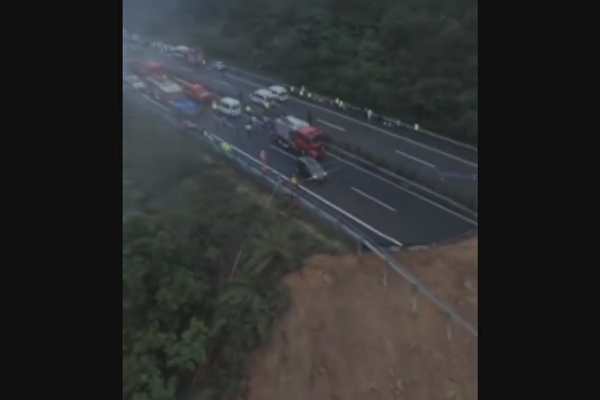On May 1, 2024, in the early hours of the morning, a section of the Meida Expressway in Meizhou, Guangdong Province suddenly collapsed, resulting in over eighty casualties, according to official reports. On January 22, this year, the provincial-level investigation report described the incident as a “disaster,” attributing the collapse to the combined effects of prolonged heavy rainfall and various factors. This conclusion has sparked discontent among internet users. Moreover, the authorities had prematurely categorized the incident as a “disaster” before conducting a thorough investigation.
In a report by the official CCTV website, it was stated that on May 1, 2024, at approximately 1:57 a.m., a collapse occurred on the Meizhou-Dabu Expressway (known as the “Meida Expressway”) eastern extension line at the K11+900 to K11+950 section, where half of the road embankment collapsed in the eastward direction, causing 23 vehicles to fall off, resulting in 52 fatalities and 30 injuries.
According to the report from the provincial government investigation and assessment team for the Meida Expressway Tea Yang section collapse on May 1, 2024, it was determined that the incident was a “particularly significant collapse disaster with heavy casualties caused by the prolonged heavy rainfall and the combined effects of multiple factors.” Factors such as light intermittent rain, poor visibility for drivers, sudden surge in traffic flow, vehicles igniting fires after falling, further exacerbated the disaster’s impact. The investigation report also highlighted issues in various aspects such as engineering surveying, design, construction, supervision, acceptance, operation, and maintenance, which had some impact on the embankment’s disaster resistance.
The investigation emphasized that prior to the disaster, Guangdong Province experienced multiple rounds of heavy rainfall, with the average precipitation breaking historical records for the same period. The main causes of the collapse disaster were attributed to the “inverted triangular” valley geology of the disaster section, which, subjected to prolonged heavy rainfall, led to the continuous accumulation of groundwater, rising water levels, increasing transient underground water pressures, buoyancy and permeability forces, and sheer sliding forces accumulating continuously. The saturated conditions at the embankment’s base and foundation due to prolonged water infiltration led to a decrease in shear strength, resulting in sudden sliding deformation of the lower and middle portions of the embankment footings, causing the collapse of the highway embankment.
The official media reports mentioned that any issues regarding the performance of public officers from the participating construction units and relevant departments discovered during the investigation would be transferred to the disciplinary and supervisory authorities for handling. Violations and irregularities would be addressed by the relevant departments.
According to official Chinese data, accidents causing more than 30 deaths or over 100 serious injuries (including acute industrial poisoning) or direct economic losses exceeding 100 million Yuan are considered “major accidents.” However, the official investigation refrained from using the word “accident” and instead opted for “disaster.”
Previously, there had been rumors circulating online about a “limit on deaths” in Chinese accidents, suggesting that when the number of casualties exceeds a certain threshold, senior officials would be demoted. Based on past practices of the Chinese Communist Party in handling accidents, it is common to hold some involved construction companies and lower-level officials accountable, imposing mild penalties on them.
Following the Meida Expressway collapse, as the official investigation report did not attribute responsibility to engineering quality issues, many mainland Chinese netizens questioned: “It is definitely an engineering quality issue.” “How does an inverted triangle exist? Was it not discovered?” “Heavy rainfall kilometers away doesn’t matter, but the collapse at the incident site is confusing the public and treating them like fools.” “What maintenance procedures are in place for highways? Are latent hazards not investigated?” “From the photos, one side of the collapsed embankment had no reinforced concrete retaining wall posts, so it’s either a design issue or a construction problem.”
Some netizens commented: “It’s unclear.” “The construction contracting units for highways have major quality issues, and those responsible should be severely punished!” “Were the concrete and steel reinforcement in the embankment base inspected for compliance?” “Shoddy construction projects cause great harm!” “Reminds me of the Zhaozhou Bridge, fine for a thousand years, then suddenly not.”
In fact, on the day following the collapse (May 2, 2024), Xinhua News Agency had already categorised the Meida Expressway collapse as a “disaster,” without a thorough investigation. On the same day, Xi Jinping issued “important instructions,” emphasizing the need to ensure “overall social stability.”
After the Meida Expressway collapse, the Chinese media outlet “Jiemian News” reported that experts and relevant departments were investigating the specific causes of the collapse, suggesting that it might be related to geological structure, erosion by rainwater, construction quality, and various other factors. At that time, online public opinion in China began to criticize the early years of the “infrastructure leap forward.”
After reviewing information related to the accident, American senior bridge structural design engineer Zhu Xueye, on May 3 last year, told Dajiyuan that this was a man-made engineering quality issue rather than a natural disaster. He stated that the quality issue had escalated from quantitative to qualitative, and moving forward, China’s buildings, roads, and bridges would experience a significant number of incidents.
Official information released previously indicated that the area of the collapse on the Meida Expressway was approximately 17.9 meters long with an area of about 184.3 square meters. Zhu Xueye explained that after pressing layers of sand and gravel for slope protection, even heavy rain would not wash it away, and it would not collapse suddenly. Therefore, the primary cause was likely an engineering quality issue rather than a so-called natural disaster, unless caused by an earthquake.

